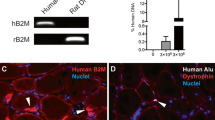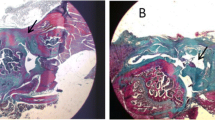Abstract
Stem cells have long been hypothesized to improve outcomes following rotator cuff repair. However, these cells must be signaled in order to do so. TGIF1 is a transcription factor that has been found to be down-regulated in cells involved in chondrogenesis. We therefore wished to examine whether stem cells expressing lower levels of TGIF1 could better improve outcomes following rotator cuff repair than stem cells expressing normal levels of TGIF1. Bone mesenchymal stem cells (BMSCs) were transduced with TGIF1 siRNA to suppress native TGIF1. Nontransduced BMSCs were also obtained for the control group. Following suprapinatus tendon repair, rats were either treated with transduced BMSCs or nontransduced BMSCs. Histologic and functional testing were performed on both groups. Rats treated with transduced TGIF1 siRNA BMSCs following suprapinatus repair expressed significantly higher levels of chondrogenic proteins at 4 weeks than rats treated with nontransduced BMSCs. Further, rats treated with BMSCs transduced with TGIF1 siRNA had both a significantly greater maximum load at failure and stiffness. Rats treated with transduced TGIF1 siRNA BMSCs following supraspinatus repair perform better both histologically and functionally at 4 weeks.




Similar content being viewed by others
References
Akyol E, Hindocha S, Khan WS (2014) Use of stem cells and growth factors in rotator cuff tendon repair. Curr Stem Cell Res Ther 10:5–10
Anz AW, Hackel JG, Nilssen EC, Andrews JR (2014) Application of biologics in the treatment of the rotator cuff, meniscus, cartilage, and osteoarthritis. J Am Acad Orthop Surg 22:68–79
Bedi A, Maak T, Walsh C, Rodeo SA, Grande D, Dines DM, Dines JS (2012) Cytokines in rotator cuff degeneration and repair. J Shoulder Elb Surg 21:218–227
Beitzel K, Solovyova O, Cote MP, Apostolakos J, Russell RP, McCarthy MB, Mazzocca AD (2013) The future role of mesenchymal stem cells in the management of shoulder disorders. Arthroscopy 29:1702–1711
Chen CH, Chang CH, Wang KC, Su CI, Liu HT, Yu CM, Wong CB, Wang IC, Whu SW, Liu HW (2011) Enhancement of rotator cuff tendon–bone healing with injectable periosteum progenitor cells-BMP-2 hydrogel in vivo. Knee Surg Sports Traumatol Arthrosc 19:1597–1607
Cheng B, Ge H, Zhou J, Zhang Q (2014) TSG-6mediatestheeffectoftendonderivedstem. Eur Rev Med Pharmacol Sci 18:247–251
Dehne T, Schenk R, Perka C, Morawietz L, Pruss A, Sittinger M, Kaps C, Ringe J (2010) Gene expression profiling of primary human articular chondrocytes in high-density micromasses reveals patterns of recovery, maintenance, re- and dedifferentiation. Gene 462:8–17
Gatto F, Redaelli D, Salvade A, Marzorati S, Sacchetti B, Ferina C, Roobrouck VD, Bertola F, Romano M, Villani G, Antolini L, Rovelli A, Verfaillie CM, Biondi A, Riminucci M, Bianco P, Serafini M (2012) Hurler disease bone marrow stromal cells exhibit altered ability to support osteoclast formation. Stem Cells Dev 21:1466–1477
Glenisson W, Castronovo V, Waltregny D (2007) Histone deacetylase 4 is required for TGFbeta1-induced myofibroblastic differentiation. Biochim Biophys Acta 1773:1572–1582
Gulotta LV, Kovacevic D, Montgomery S, Ehteshami JR, Packer JD, Rodeo SA (2010) Stem cells genetically modified with the developmental gene MT1-MMP improve regeneration of the supraspinatus tendon-to-bone insertion site. Am J Sports Med 38:1429–1437
Gulotta LV, Kovacevic D, Packer JD, Ehteshami JR, Rodeo SA (2011) Adenoviral-mediated gene transfer of human bone morphogenetic protein-13 does not improve rotator cuff healing in a rat model. Am J Sports Med 39:180–187
Huang HS, Liu ZM, Chen PC, Tseng HY, Yeh BW (2012) TG-interacting factor-induced superoxide production from NADPH oxidase contributes to the migration/invasion of urothelial carcinoma. Free Radic Biol Med 53:769–778
Jo CH, Shin JS, Park IW, Kim H, Lee SY (2013) Multiple channeling improves the structural integrity of rotator cuff repair. Am J Sports Med 41:2650–2657
Liborio TN, Ferreira EN, Aquino Xavier FC, Carraro DM, Kowalski LP, Soares FA, Nunes FD (2013) TGIF1 splicing variant 8 is overexpressed in oral squamous cell carcinoma and is related to pathologic and clinical behavior. Oral Surg Oral Med Oral Pathol Oral Radiol 116:614–625
Liu X, Zhang Z, Yan X, Liu H, Zhang L, Yao A, Guo C, Liu X, Xu T (2014a) The Rho kinase inhibitor Y-27632 facilitates the differentiation of bone marrow mesenchymal stem cells. J Mol Histol 45:707–714
Liu X, Zuo D, Fan H, Tang Q, Shou Z, Cao D, Zou Z (2014b) Over-expression of CXCR4 on mesenchymal stem cells protect against experimental colitis via immunomodulatory functions in impaired tissue. J Mol Histol 45:181–193
Lorda-Diez CI, Montero JA, Martinez-Cue C, Garcia-Porrero JA, Hurle JM (2009) Transforming growth factors beta coordinate cartilage and tendon differentiation in the developing limb mesenchyme. J Biol Chem 284:29988–29996
Melhuish TA, Chung DD, Bjerke GA, Wotton D (2010) Tgif1 represses apolipoprotein gene expression in liver. J Cell Biochem 111:380–390
Mercier S, Dubourg C, Garcelon N, Campillo-Gimenez B, Gicquel I, Belleguic M, Ratie L, Pasquier L, Loget P, Bendavid C, Jaillard S, Rochard L, Quelin C, Dupe V, David V, Odent S (2011) New findings for phenotype-genotype correlations in a large European series of holoprosencephaly cases. J Med Genet 48:752–760
Paulussen AD, Schrander-Stumpel CT, Tserpelis DC, Spee MK, Stegmann AP, Mancini GM, Brooks AS, Collee M, Maat-Kievit A, Simon ME, van Bever Y, Stolte-Dijkstra I, Kerstjens-Frederikse WS, Herkert JC, van Essen AJ, Lichtenbelt KD, van Haeringen A, Kwee ML, Lachmeijer AM, Tan-Sindhunata GM, van Maarle MC, Arens YH, Smeets EE, de Die-Smulders CE, Engelen JJ, Smeets HJ, Herbergs J (2010) The unfolding clinical spectrum of holoprosencephaly due to mutations in SHH, ZIC2, SIX3 and TGIF genes. Eur J Hum Genet 18:999–1005
Pramfalk C, Eriksson M, Parini P (2015) Role of TG-interacting factor (Tgif) in lipid metabolism. Biochim Biophys Acta 1851:9–12
Sandgren J, Andersson R, Rada-Iglesias A, Enroth S, Akerstrom G, Dumanski JP, Komorowski J, Westin G, Wadelius C (2010) Integrative epigenomic and genomic analysis of malignant pheochromocytoma. Exp Mol Med 42:484–502
Tan Q, Lui PP, Rui YF, Wong YM (2012) Comparison of potentials of stem cells isolated from tendon and bone marrow for musculoskeletal tissue engineering. Tissue Eng Part A 18:840–851
Taniguchi K, Anderson AE, Sutherland AE, Wotton D (2012) Loss of Tgif function causes holoprosencephaly by disrupting the SHH signaling pathway. PLoS Genet 8:e1002524
Vaaralahti K, Raivio T, Koivu R, Valanne L, Laitinen EM, Tommiska J (2012) Genetic Overlap between holoprosencephaly and Kallmann Syndrome. Mol Syndromol 3:1–5
Valencia Mora M, Antuna Antuna S, Garcia Arranz M, Carrascal MT, Barco R (2014) Application of adipose tissue-derived stem cells in a rat rotator cuff repair model. Injury 45(Suppl 4):S22–S27
Wang Y, Yin Y, Jiang F, Chen N (2015) Human amnion mesenchymal stem cells promote proliferation and osteogenic differentiation in human bone marrow mesenchymal stem cells. J Mol Histol 46:13–20
Willer A, Jakobsen JS, Ohlsson E, Rapin N, Waage J, Billing M, Bullinger L, Karlsson S, Porse BT (2014) TGIF1 is a negative regulator of MLL-rearranged acute myeloid leukemia. Leukemia
Wu B, Ma X, Zhu D, Liu Y, Sun Z, Liu S, Xue B, Du M, Yin X (2013) Lentiviral delivery of biglycan promotes proliferation and increases osteogenic potential of bone marrow-derived mesenchymal stem cells in vitro. J Mol Histol 44:423–431
Yeh BW, Wu WJ, Li WM, Li CC, Huang CN, Kang WY, Liu ZM, Huang HS (2012) Overexpression of TG-interacting factor is associated with worse prognosis in upper urinary tract urothelial carcinoma. Am J Pathol 181:1044–1055
Ylarinne JH, Qu C, Lammi MJ (2014) Hypertonic conditions enhance cartilage formation in scaffold-free primary chondrocyte cultures. Cell Tissue Res 358:541–550
Zhang Q, Zhou J, Ge H, Cheng B (2013) Tgif1 and SnoN modified chondrocytes or stem cells for tendon–bone insertion regeneration. Med Hypotheses 81:163–166
Zhao S, Peng L, Xie G, Li D, Zhao J, Ning C (2014) Effect of the interposition of calcium phosphate materials on tendon–bone healing during repair of chronic rotator cuff tear. Am J Sports Med 42:1920–1929
Acknowledgments
This work was supported by grants from Natural Science Foundation of China (No. 81372005).
Conflict of interest
The authors declare no conflict of interest.
Author information
Authors and Affiliations
Corresponding authors
Additional information
Jie Li and Liyang Chen have contributed equally to this work.
Rights and permissions
About this article
Cite this article
Li, J., Chen, L., Sun, L. et al. Silencing of TGIF1 in bone mesenchymal stem cells applied to the post-operative rotator cuff improves both functional and histologic outcomes. J Mol Hist 46, 241–249 (2015). https://doi.org/10.1007/s10735-015-9615-6
Received:
Accepted:
Published:
Issue Date:
DOI: https://doi.org/10.1007/s10735-015-9615-6




